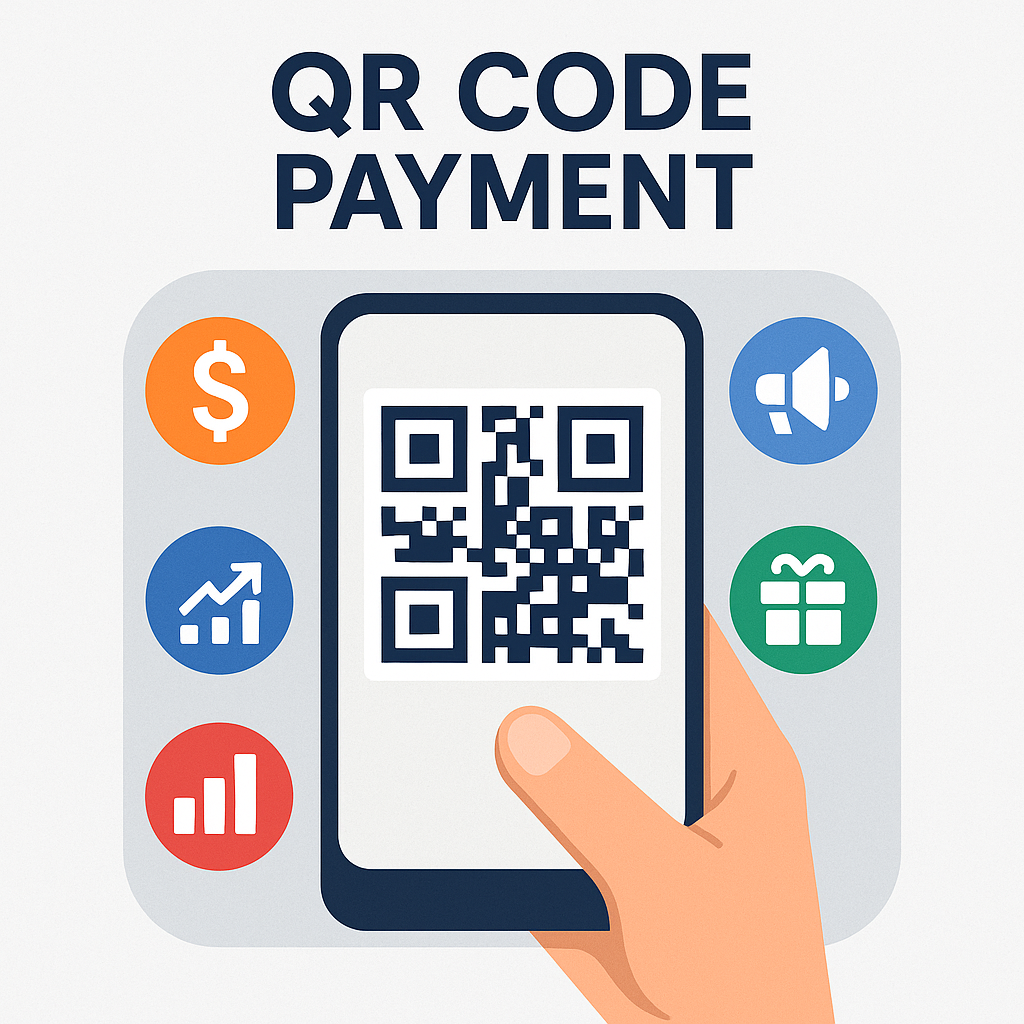The Rise of QR Code Payments: By the Numbers
The momentum is undeniable. In Brazil, Pix (the Central Bank’s instant payment system) processed a record 250.5 million transactions in a single day on April 6, 2024, handling BRL 124.4 billion. By July 2024, Pix transactions had reached almost R$2.5 trillion per month, with over 70% of the country (more than 150 million people) actively using it. In China, the scale is even larger. Alipay holds about 53% market share with WeChat Pay at roughly 42%, accounting for over 90% of China’s mobile payments market, with total mobile transaction volume reaching an estimated $20.1 trillion through Alipay in 2025. QR code-based payments made up 92% of Alipay’s in-store transactions. In India, UPI-powered QR payments are driving digital inclusion, even in rural areas where traditional banking infrastructure is limited. This isn’t regional—it’s global transformation.How QR Code Payments Work
The mechanics are elegant in their simplicity. Step 1: Merchant generates a QR code – A unique code is created, linked to a specific transaction amount, recipient account, or merchant identifier. Step 2: Customer scans with their phone – Using any smartphone camera or a payment app, the customer points at the code. Step 3: Payment details appear – The app translates the code into actionable information: amount, recipient, transaction purpose. Step 4: Customer approves – A single tap confirms the transaction. Step 5: Instant confirmation – Both merchant and customer receive immediate notification, often within seconds. No card readers. No wireless terminals. No special equipment. Just a smartphone and a camera—technology nearly everyone already has.Static vs. Dynamic QR Codes: What’s the Difference?
Static QR codes contain fixed information—a permanent payment address or account number. They’re ideal for small businesses, street vendors, or personal transfers. Once generated, they don’t change. Dynamic QR codes are generated fresh for each transaction, containing real-time details like specific amounts, invoice IDs, and transaction references. These are preferred for retail, restaurants, and enterprise-level payments because they’re more secure and trackable.Global Adoption Across Markets
Brazil: Pix as Infrastructure
A striking 82% of Brazilian consumers said Pix makes a positive or very positive impact on their lives, with 43% using it daily compared to only 29% for credit cards and 21% for cash. This Central Bank initiative has become the backbone of Brazilian commerce. Street markets, food trucks, and massive retailers all accept QR payments. In 2025, the Central Bank rolled out Pix Automático, enabling recurring payments with customer consent for subscriptions, bills, and memberships.China: The QR Code Standard
In China, cash has virtually disappeared from urban transactions. Alipay and WeChat Pay dominate through QR codes at point-of-sale terminals. From paying for subway fares to splitting restaurant bills, QR scanning has become the default method.India: Financial Inclusion at Scale
India’s Unified Payments Interface (UPI) uses QR codes to bring banking to rural and remote areas. Rather than relying on traditional infrastructure, QR codes enable shopkeepers, farmers, and street vendors to accept payments instantly without bank connections or expensive hardware.Europe and North America: The Emerging Frontier
Across Europe, retail chains are deploying QR-based self-checkout kiosks. Meanwhile, adoption in North America remains slower but is accelerating, particularly in restaurants, delivery services, and newer fintech platforms.Why QR Code Payments Are Winning
1. Near-zero infrastructure costs – No card machines. No terminals. No wireless infrastructure required beyond what already exists. 2. Universal compatibility – Any smartphone camera can read a QR code. Moreover, no special apps are required, though dedicated apps enhance security and speed. 3. Financial inclusion – Unbanked populations can access digital payments with just a phone. This benefit is transformative for developing markets. 4. Real-time data – Merchants instantly see transaction details, customer behavior, and payment patterns. Consequently, this intelligence drives better business decisions. 5. Security – Dynamic QR codes significantly reduce fraud risk compared to static payment information. Since each transaction generates a unique code, interception becomes nearly impossible. 6. Scalability – The system works equally well for a street vendor processing one transaction or a multinational retailer processing thousands per minute.Marketing and Retail Applications
QR code payments have moved beyond pure transactions into customer engagement and loyalty. Restaurants and Cafés: Digital menus linked to payment QR codes allow instant ordering and payment. Loyalty programs track every scan, rewarding frequent customers with points or discounts. Retail chains: Self-checkout kiosks use QR codes to reduce checkout time. Promotional campaigns embed QR codes in packaging, linking to exclusive content or discounts. Events: Ticket validation via QR code. Sponsor engagement through scannable codes that unlock exclusive content or prizes. Loyalty programs: Brands gamify the payment experience—scan to unlock rewards, earn points toward future purchases, or participate in contests. Example: Starbucks in Asia integrates QR code payments into its mobile app, allowing seamless ordering, payment, and loyalty tracking in a single scan.The Security Advantage
A common misconception is that QR codes are less secure than traditional payments. The opposite is often true. Dynamic QR codes are generated fresh for each transaction. An intercepted code has no value because it’s transaction-specific and time-sensitive. Encrypted redirects ensure that scanning a code doesn’t expose sensitive data. Real-time verification systems validate that the code came from a legitimate merchant before processing payment. The actual risk comes from malicious QR codes—codes that redirect to phishing sites or fraudulent payment pages. This is a problem with the code’s destination, not the technology itself. Safe platforms mitigate this through merchant verification and validation layers.Gamification: Engagement Beyond Payment
The future of QR code payments isn’t just about speed—it’s about experience. Forward-thinking platforms are integrating gamification into payment experiences. Customers earn digital rewards for frequent scans, unlock exclusive content, or participate in campaigns that combine payment with engagement. This transforms QR codes from utilities into mini-experiences—turning a mundane transaction into a moment of delight that encourages repeat usage and builds brand loyalty.Transform QR payments into engagement and rewards
VISU connects every QR payment to campaigns, rewards, and real-time analytics — so you can see, prove, and scale the impact of every scan.The Road Ahead
QR code payments represent infrastructure rather than a temporary trend. Financial institutions, governments, and businesses are investing heavily in standardization, interoperability, and expansion. Notably, December 2024 B2B volume for Pix exceeded R$1 trillion (approximately $200 billion USD), marking a 56% year-over-year increase and demonstrating that QR payments are scaling beyond consumer use. As technologies like NFC and blockchain continue to evolve, QR codes will coexist and integrate with these systems rather than disappear. The low cost and universal compatibility that make QR codes powerful ensure they’ll remain central to global payments for decades to come.Conclusion
QR code payments represent one of the most significant shifts in how humans exchange value. They’re faster, cheaper, and more accessible than traditional payment systems. They drive financial inclusion for unbanked populations. They create opportunities for businesses to engage customers in new ways. For businesses, governments, and individuals, understanding and adopting QR code payments isn’t optional anymore—it’s essential to participating in the digital economy. The question isn’t whether QR code payments will scale. They already have. The question is how you’ll leverage them.FAQ: QR Code Payments
How do QR code payments work in practice?
The merchant shows a QR code linked to their account or a specific transaction. The customer scans it with a banking or wallet app, confirms the details and authorizes the payment. Funds are transferred instantly and both sides receive confirmation in seconds.
Are QR code payments safe?
Yes, when used through trusted banking and fintech apps. Dynamic QR codes, encryption and real-time verification make it hard for attackers to intercept or reuse a code. The main risk comes from malicious codes placed by scammers, so users should always check the URL or app screen before confirming.
Do I need special hardware to accept QR payments?
No. Most merchants only need a smartphone and an account with a bank or payment provider that supports QR codes. The system generates printable or on-screen codes, so there is no need for traditional card terminals or expensive POS hardware.
Are QR code fees lower than card payments?
In many markets, yes. Systems like Pix or UPI typically charge lower fees than credit cards, especially for small businesses and P2P transfers. Exact costs depend on the bank or provider, but QR payments are usually positioned as a low-cost alternative to traditional acquiring.
How can a small business start using QR code payments?
Open an account with a bank or fintech that offers QR acceptance, generate a merchant QR code inside the app, print or display it at the point of sale, and train staff to guide customers through scanning and confirming the payment. From there, use analytics to understand peak times, ticket size and repeat customers.


